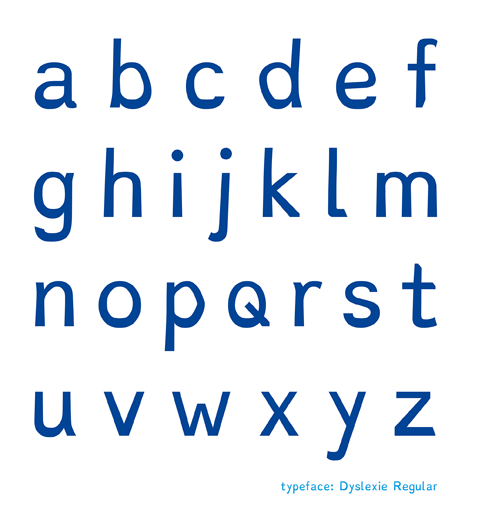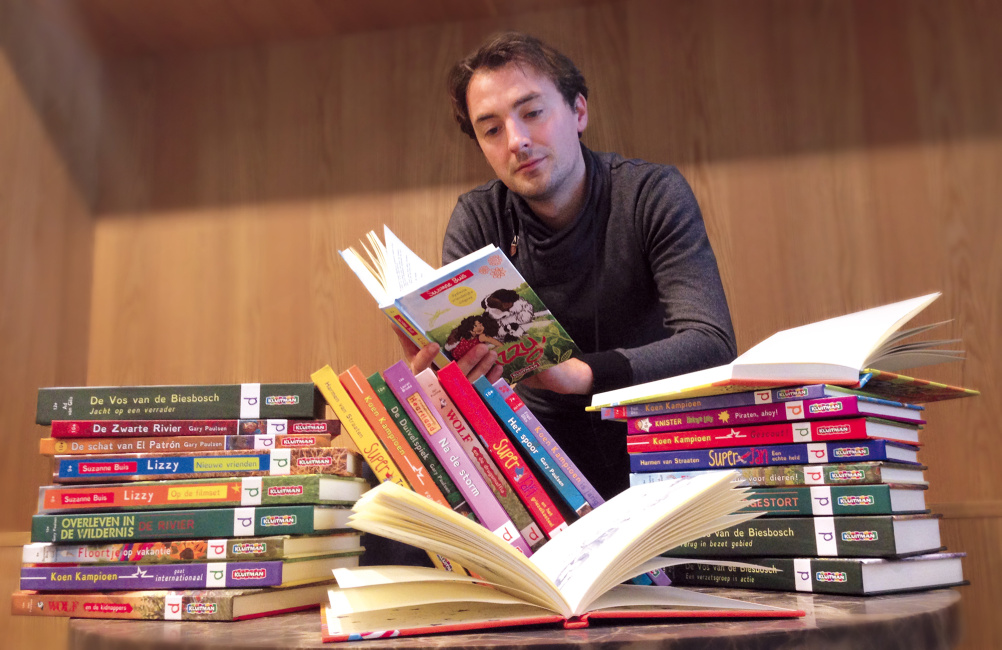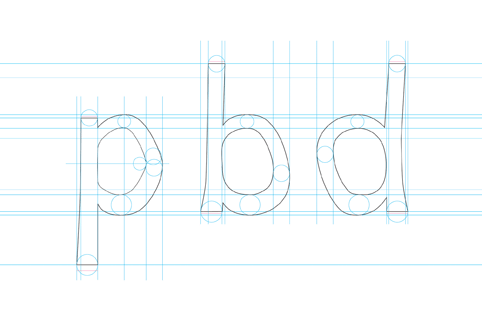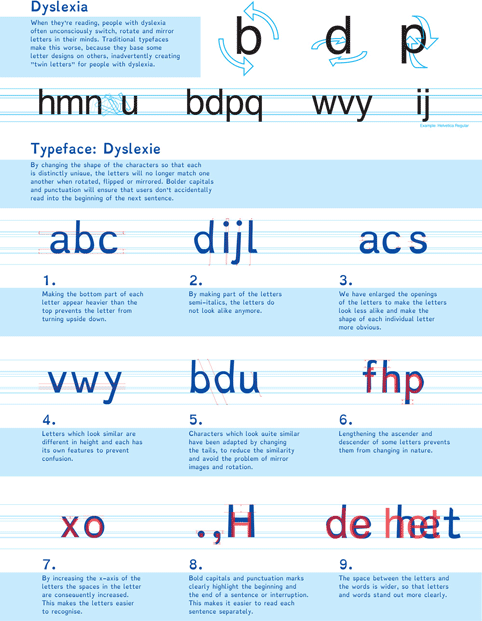The concept behind Dyslexie – the font for people with dyslexia
Dutch freelance graphic designer Christian Boer created a font especially designed for dyslexic people in 2008, as part of a final university project. Six years later, it’s available in over ten languages, and is being used by around 2,000 companies, including the likes of Nintendo, Shell, Pixar Animation Studios and the Penguin Group. Design Week speaks to Boer about the inspiration and concept behind the font – and why he’s more of a Comic Sans-man than Times New Roman.

Design Week: Why did you design the Dyslexie font? What was your inspiration?
Christian Boer: My own dyslexia – I’ve always struggled with it. I completed a lower level of education at school because of it, even though I had good grades. I had to take a detour, like most people with dyslexia, completing follow up education then going on to do a Bachelors degree in design. I used to run away from my condition – then I studied at Utrecht Art Academy, and had to complete a final thesis project in 2008. I decided to do something about it, so I conducted research into typefaces for dyslexia.
DW: How does Dyslexie work?
CB: When working on my graduation project, I started reading about how dyslexic people subconsciously mirror, switch and turn letters, creating “twin letters” – where they are unable to distinguish between two similar-looking symbols. But dyslexic people only struggle with two-dimensional objects – for example, if you turn a cup of coffee upside down, they’ll still know it’s a cup of coffee. So I treated letters as three-dimensional objects instead – I adjusted them, making them more distinctive and easier to differentiate between, helping the reader to stop creating twin letters. This made it easier for them to read, and stopped them making errors. I needed to work on all the symbols, because dyslexia ranges from light to severe, and people have their own problem letters. Some have trouble with d and b, and others s and z – it’s not the same for everyone.

DW: What does the Dyslexie font look like?
CB: The bottom half of the letters are bigger and bolder. Openings are bigger, and some letters are slanted whilst others are straight, helping to differentiate between them. The full stops and capital letters between sentences are also bolder – this forces the reader to stop, so they don’t run sentences together. Some letters have been lengthened in height, making them easier to recognise.
DW: What was the design process like?
CB: I had an idea in my head of my concept of 3D letters. At first, I only created it in lower case, to test if it worked. It worked for me, so I then tested it on my university group – it worked for them, so I then developed it further. My first design and last design are very similar – 99 per cent of people wouldn’t be able to tell the difference.

DW: What has research shown from use of the font?
CB: Research was conducted in 2012, speaking to dyslexic children and adults, and parents and teachers who work with children with dyslexia. Out of those surveyed, over 80 per cent said they, or their child, could read faster using the font, while over three quarters said they made less mistakes and that they would advise others to use the font. Results also indicate that reading became a more pleasant experience. More research was undertaken by the University of Twente and University of Amsterdam in 2013.
DW: Does Dyslexie work better in a particular font size, style or colour?
CB: There’s been research conducted on this with use of any font. It found that with black letters on white paper, the contrast is too high. It’s preferable to have dark blue letters on an off-white background. From my experience, even those who don’t have dyslexia like to set their letters to 80 per cent black! It’s also easier to read on paper rather than on screen, because the light is reflective rather than coming from the screen itself, so it’s less tiring for your eyes. Font size can be kept the same as for non-dyslexic people. When someone first starts reading, it should be at 14pt or 16pt. When they get to about age 12, it should go down to 10pt. Unless it’s in the Dyslexie typeface, italics are really hard for dyslexic people to read – the letters slant off each other, creating a crowding effect where the letters smelt together. With Dyslexie, I’ve reduced the slant of the italics font by condensing the font in size. This reduces the regular 20 per cent slant to a 10 per cent slant for the eye – so it looks like it’s italic, but it’s not really, making it easier to read.

DW: Have you seen any examples of dramatic transformation from use of Dyslexie?
CB: Many companies now use Dyslexie, including Shell. One of the managers there is dyslexic – he told me that, in order for him to catch up with his colleagues on work, he had to spend every weekend reading. Now that he uses the font, he has his weekends back for the first time in 15 years. Another man I’ve worked with has a son with dyslexia, who wanted to drop out of school. Now he’s started using the font, he’s finished school and is training to become a pilot. It can be very frustrating for people with dyslexia, as it can take five times more energy for them to read something. I’m trying to help people waste less effort and time, while encouraging them to read more and get better – so they can be more independent, get through school and do their jobs.
DW: Where would you personally like to see Dyslexie used?
CB: E-readers would be great – there would be a lot of books available in one place. Also, I’d like to see it used for educational purposes – in Italy and Belgium there are educational books that use the Dyslexie typeface. What I really want is for people to be able to choose it everywhere, on any device.
DW: What’s your favourite font – other than Dyslexie of course – and why?
CB: I don’t have a favourite – I’m a concept kind of guy. I once made a book for somebody who had found a diary of their father’s, who had been captured by the Germans in the war – he asked me to use Dyslexie for the font, and I said no because I wanted to use a handwritten typeface for what his father had written, and another for research and background information. It’s about the typeface fitting the idea behind the design.

DW: And your least favourite?
CB: To read with, it’s Times New Roman – it’s one of the most complete typefaces in the world with so many symbols, but I have a hard time with it.
DW: Other than your own, what fonts do you think dyslexic people find easier to read?
CB: Out of the 90,000 typefaces that exist, there are obviously some with letters that stand out more. Schools tend to use Verdana and Comic Sans. I did some research, applying my rules to those typefaces, and I found that those who have problems with e or with d and b should use Comic Sans, but those who have problems with u and m and n should use Verdana – the problem is, a school might decide that Verdana is a good font to use, and some of the children with dyslexia will still struggle.
DW: Are there any imminent future developments for the Dyslexie font?
CB: Every year, I expand it to more languages. When I first designed it, it was only in Dutch as I thought I was the only one who would be using it – now, it’s available in Dutch, English, German, French, Icelandic, Swedish, Danish, Norwegian, Italian, Spanish and Turkish. It takes me around 20 hours to design each sign or symbol – then I need to create it in regular, bold, italic and bold italic, so I keep a month free to design one language. I’ve almost finished designing it in Polish, and I’m hoping to add Russian Cyrillic within the next two years.
Boer’s Dyslexie font can be downloaded for free from his official website. More research on the typeface can be found here.
-
Post a comment




